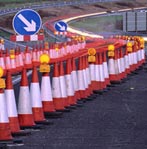8/16/2005
UK Study: Speed Cameras Increase Injury AccidentsFull text of suppressed UK government study shows speed cameras increase accidents 31 percent on freeways, 55 percent in work zones.

The UK Department for Transport funded, then suppressed, a study that shows a 55 percent increase in injury accidents when speed cameras are used on highway work zones and a 31 percent increase when used on freeways without construction projects. According to the Transport Research Laboratory, the "non-works [personal injury accident] rate is significantly higher for the sites with speed cameras than the rate for sites without."
An analysis of this data, buried on page 43 of the report, yields the following result:
Effect on Personal Injury Accidents Enforcement Type Construction Zone No Construction
Conventional speed cameras55% increase 31% increase Speed-averaging cameras (SPECS) 4.5% increase 6.7% increase Police patrols 27% reduction 10% reduction
View Table 3.18 in original format
Although the Department for Transport's Highways Agency funded the study, no information regarding these results was ever made public until a Freedom of Information Act request was honored earlier this month. The Transport Research Laboratory attempted to suppress the UK taxpayer-funded study further by charging £40 (US $72) for access to the results. Moreover, the study's executive summary calculates only the aggregate accident rate including the benefit of manned police patrol cars in the work zones. The significant decrease in accidents from a human police presence was used to offset the increase in camera accidents.
"It is outrageous that this sort of information has been hidden from the public," said Safe Speed road safety campaign founder Paul Smith whose FOIA request uncovered the study's existence. "We have all seen strange driver behaviour where fixed speed cameras operate. This report highlights the dangers. We're not surprised to see this information -- we have know for years that speed cameras were the wrong road safety strategy, and it's a huge relief to see the truth coming out so clearly"
The TRL study compared accident reports covering 29 highway construction zone projects over 730km of road from November 2001 to July 2003 with an equivalent period without the construction zones, controlling for changes in traffic volume. In the US, the state of Illinois plans to implement a similar freeway work zone speed camera program within the next few months.
The full text of this taxpayer-funded public policy document is available in 620K PDF format at the source link below.


